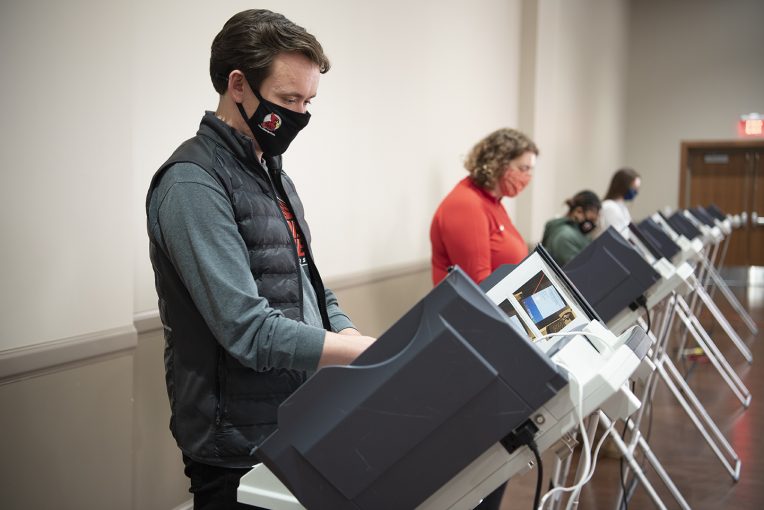The good news is 87 percent of Illinois State University students responding to the ISU Student Voter Engagement Survey said they are registered to vote. The not-so-good news is only 40 percent said they are likely to vote in the general election Nov. 8.
But that was last spring, and a lot has changed since Dr. Meghan Leonard conducted the survey, including the U.S. Supreme Court’s ruling overturning of Roe v. Wade.
“I would think there would be much greater interest in voting in the general election,” the politics and government professor said.
Voter apathy isn’t the reason college students aren’t going to the polls in greater numbers. Frequent address changes, figuring out where to vote, and first-time voter anxiety all come into play.
“We know from research students aren’t unengaged,” Leonard said. “We see them protesting, holding boycotts, coming out of college and working to unionize. Students are very, very engaged in politics, but we’ve had trouble turning that into the voting process. If you’re moving four times in four years, that makes it hard.”
“In order to get students to vote, we have to support them and help them overcome that anxiety of voting.”
Dr. Meghan Leonard
The survey was part of Leonard’s research after being named a 2022 Electoral Engagement Fellow by the Center for Civic Engagement. The center awarded two faculty/staff fellowships and one student fellowship last fall to support the University’s core value of civic engagement. Dr. Joseph Zompetti was named the Civic& Digital Literacy Fellow, and Michael Severino the Student Civic Engagement Fellow. Nominations will open Nov. 15 for the 2023-2024 program, which includes a $5,000 stipend.
In Leonard’s survey, students said registering was the easy part; 70 percent registered online. But figuring out where to vote, who to vote for, and what to do at the polling place was more difficult.
“In order to get students to vote, we have to support them and help them overcome that anxiety of voting,” she said.
That includes providing information about campus polling locations and helping students learn more about the voting process, including how to can ask for help at the ballot box. Explaining the importance of voting in mid-term elections is important too, she added.
This year there are several judges on the ballot. Leonard created the Illinois Judicial Elections Guide, which provides information on what state court judges and justices do, how they’re elected, and where you can go to find out more about those on the ballot.
Of the 430 responses used for the voter engagement survey, 49 percent were men; 46 percent women, and 5 percent identified as nonbinary or transgender. Seventy-one percent were white; 15 percent Black, 3 percent Hispanic or Latino, and the rest fell in other categories. Fifty-three percent identified as members of the LGBTQ+ community.
Thirty-seven percent were Democrats, 28 percent Republicans, and 33 percent did not identify with a party or selected another party. Fifty-two percent identified as strongly to somewhat liberal, 8 percent as strongly or somewhat conservative, and the other 39 percent as neither.
Race played a role in voter registration. White students were registered at a higher percentage than their Black and Latinx counterparts. While the difference between white and Black students was not statistically significant, the difference between white and Latinx students was.
“One of the differences is citizenship,” Leonard said. “Latinx students are more likely to be immigrants or first-generation Americans. They might have parents or grandparents who couldn’t register to vote. We know students who learn to vote with their parents are much more likely to vote.”
Leonard recommended more voter registration efforts targeted toward the Latinx community.
The survey also found a student’s major played a role. Business majors were less likely to be registered, but there was no clear explanation why, she said.
“We’ve always assumed that students in the humanities and social sciences might be more likely to be registered and that STEM (Science, Technology, Engineering and Math) majors less likely, but business and education are more likely to be in the middle.”
Although the percentage of students saying they will vote in November was low, Leonard was encouraged the 40 percent who said they are likely to was higher than the 31 percent that turned out for the 2018 mid-term election.
“ISU is successful in many areas of the voting process,” she said.
The CCE’s website has an easy-to-use Redbird Voter Guide with information on how to register and vote, along with information about candidates’ positions.

